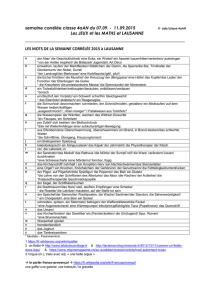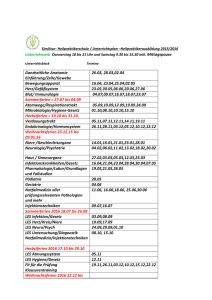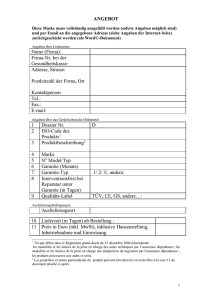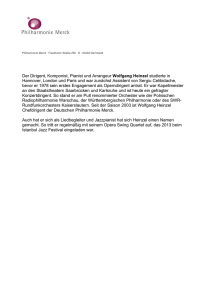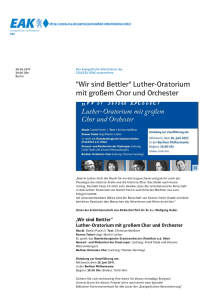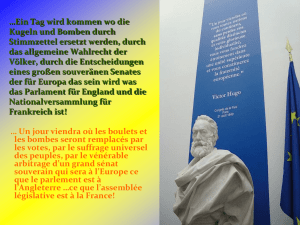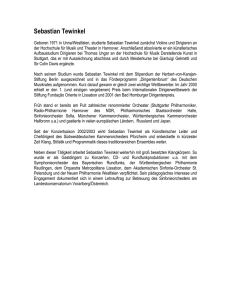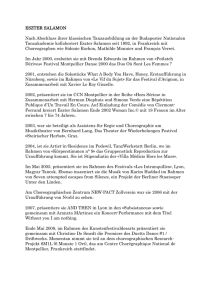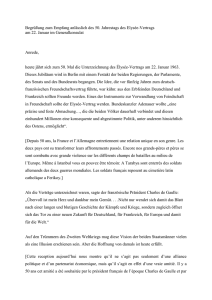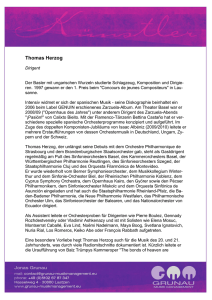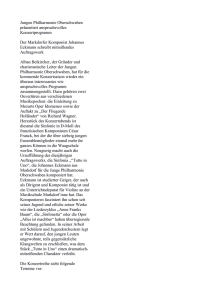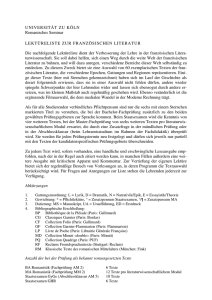The foyer hall - Philharmonie Luxembourg
Werbung
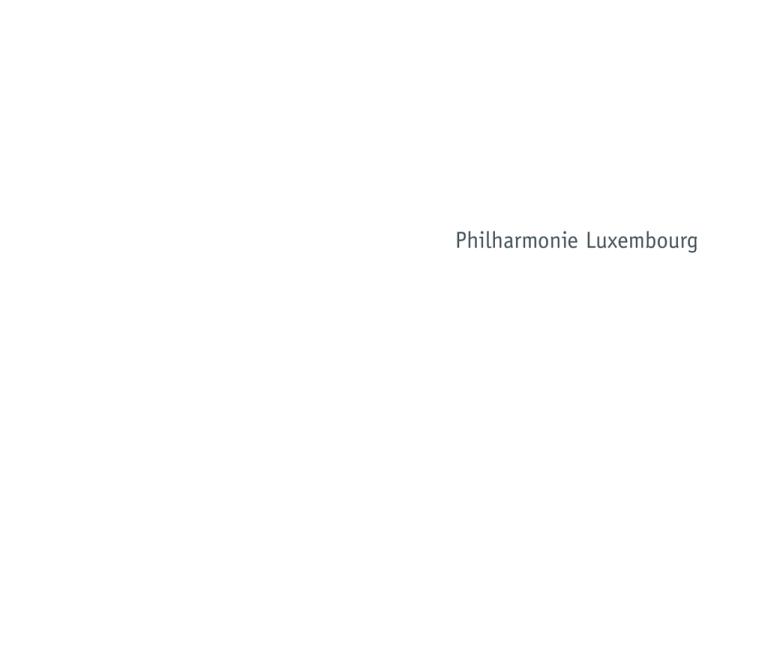
Philharmonie Luxembourg Préface Vorwort Foreword Claude Wiseler Ministre des Travaux publics Un diamant taillé sur mesure La salle de concert Grande-Duchesse Joséphine-Charlotte offre au Luxembourg la chance unique de donner les moyens tant à l'Orchestre Philharmonique du Luxembourg qu'à de nombreux artistes nationaux et internationaux de se produire dans un cadre acoustique et architectural exceptionnel. La Philharmonie devrait permettre au Luxembourg de s'imposer comme l'un des lieux de concert les plus importants et d'accroître l'attractivité culturelle et économique de la ville et du pays. Le concept de la Place de l'Europe, élaboré par l'architecte et urbaniste Ricardo Bofill en 1996 à la demande du Gouvernement, prévoyait un bâtiment central sur une place triangulaire entre l'avenue John F. Kennedy, le bâtiment Robert Schuman et le Centre de conférences. La salle de concert, sertie comme un diamant au cœur des bâtiments qui l'entourent, s'intègre harmonieusement dans l'ensemble urbanistique environnant. En 1997, Christian de Portzamparc sortait lauréat du concours d'architectes lancé par l'Administration des Bâtiments publics grâce à son concept convaincant et diversifié. En outre, il jouit d’une renommée acquise notamment avec la réalisation de la Cité de la Musique à Paris. La Philharmonie du Luxembourg, grâce à son atmosphère accueillante, prépare le mélomane à l'événement culturel. L'architecte a exprimé par sa conception architecturale, une sensibilité musicale. Je tiens à remercier tous ceux qui ont contribué à la réalisation et à l’achèvement de cette construction dans le délai prévu de trois ans et demi, pour clôturer la Présidence luxembourgeoise de l'Union européenne. En effet, ces personnes ont fait face avec enthousiasme aux défis insoupçonnés tant au niveau de la conception que de la mise en œuvre de cet ambitieux projet, un enthousiasme qui n'échappera pas aux visiteurs de la salle de concert. A présent, je vous invite à découvrir pas à pas les différentes phases de réalisation de la Philharmonie du Luxembourg et à accéder au monde de la musique à travers les portes de ce bâtiment. 4 5 Claude Wiseler Minister für öffentliche Bauten Ein Juwel hat seinen letzten Schliff erhalten Luxemburg erhält mit diesem Konzerthaus, der ”Salle de Concert Grande-Duchesse Joséphine-Charlotte“ die einmalige Chance, dem Luxemburger Philharmonie Orchester und vielen nationalen sowie internationalen Künstlern einen besonderen akustischen und architektonischen Rahmen für ihre Kunst zu bieten. Mit der neuen Philharmonie dürfte es Luxemburg gelingen, sich international zu einem der wichtigsten Konzertorte zu profilieren und so die kulturelle und wirtschaftliche Attraktivität der Stadt und des Landes zu steigern. Das 1996 im Auftrag der Regierung vom Architekten und Stadtplaner Ricardo Bofill entwickelte Konzept für die Place de l’Europe sah auf dem dreieckigen Grundriss zwischen Avenue John F. Kennedy, dem Robert-Schuman-Gebäude und dem Konferenzzentrum ein zentrales Gebäude vor, das dem Platz und der Umgebung einen besonderen Akzent verleihen sollte. Wie ein von den umliegenden Gebäuden gefasstes Juwel sollte hier das Konzerthaus erstrahlen und sich gleichzeitig in das urbane Ensemble einfügen. Als Sieger des von der Bautenverwaltung ausgeschriebenen Architektenwettbewerbs ging 1997 Christian de Portzamparc hervor. Er stellte nicht nur ein überzeugendes, vielschichtiges Konzept vor, sondern hatte sich bereits mit der Errichtung anderer Konzerthäuser wie der ”Cité de la Musique“ in Paris einen Namen gemacht. Das Außergewöhnliche an der Luxemburger Philharmonie ist, dass sie eine einladende Atmosphäre ausstrahlt, die den Musikliebhaber auf das bevorstehende Kulturerlebnis vorbereitet. Der Architekt hat es verstanden, mit dem Bau eine architektonische Hinführung zur Musik zu schaffen. An dieser Stelle möchte ich all denen danken, die es ermöglicht haben, ein so einzigartiges Gebäude in nur dreieinhalb Jahren termingerecht zum Abschluss der Luxemburger EU-Präsidentschaft fertigzustellen. Die vielen Menschen, die sich bei der Planung und Umsetzung dieses ambitionierten Projektes oft vor ungeahnte Herausforderungen gestellt sahen, meisterten diese mit Begeisterung – eine Begeisterung, die auch die Besucher des Konzerthauses ergreifen wird. Ich lade Sie ein, sich dem Entstehungsprozess und den Besonderheiten der Luxemburger Philharmonie schrittweise zu nähern und sich durch das Gebäude in die Welt der Musik einladen zu lassen. Claude Wiseler Minister of Public Works A jewel receives its final polish With the Philharmonie, the “Salle de Concert Grand-Duchesse Joséphine-Charlotte”, Luxembourg has a unique opportunity to offer the “Orchestre Philharmonique du Luxembourg” as well as national and international artists a very special acoustic and architectural setting for their art. This Philharmonie will very soon compete with the most important concert venues internationally, thus increasing the cultural and economic attraction of the city and country. Commissioned by the Government in 1996, the architect and urban planner Ricardo Bofill developed a concept for the Place de l’Europe which foresaw a central building on the triangular plot of land between the Avenue John F. Kennedy, the Robert Schuman Building and the Conference Centre. The concert hall would glisten like a jewel in the setting of the buildings which surround it, at the same time fitting perfectly into the urban environment. The extraordinary feature of the Luxembourg Philharmonie is that it exudes a welcoming air, preparing the guest for the forthcoming cultural event. With this building, the architect has managed perfectly to create an architectural introduction to music. Let me thank those who made it possible to create such a unique building in just three and a half years, perfectly in time for the close of Luxembourg’s EU Presidency. The many people who were involved in the planning and realisation of this ambitious project mastered the challenge with total enthusiasm, an enthusiasm which will also seize all those who visit the Concert Hall. I invite you to step a little closer to the process of creation and the special features of the Luxembourg Philharmonie, and to enter through the building into the world of music. As winner of the 1997 architectural competition set by the Administration of Public Works, Christian de Portzamparc has presented a convincing, multi-faceted concept, and had already established a great reputation with his construction of the “Cité de la Musique” in Paris. 6 7 La Philharmonie sur la Place de l’Europe Die Philharmonie auf der Place de l’Europe The Philharmonie in the Place de l’Europe Située à l'entrée du Plateau de Kirchberg, nouveau quartier de la ville de Luxembourg, à la fois centre européen et bancaire, quartier résidentiel et commercial, la Place de l'Europe est entourée du Centre de conférences et du bâtiment Robert Schuman. Il s'agit d'une place triangulaire conçue par Ricardo Bofill, au milieu de laquelle la salle de concert, elliptique et visionnaire a vu le jour. Les deux angles opposés du bâtiment sont orientés vers la vieille ville au sud et vers l'avenue John F. Kennedy, le grand boulevard urbain, au nord. La Philharmonie, à proximité immédiate du Musée d'art moderne Grand-Duc Jean, appelé Musée Pei et du Musée de la Forteresse, fait du quartier un centre d'attraction culturel tout en l'animant en dehors des heures de bureau. Ainsi, ce quartier est désormais plus étroitement relié au cœur historique de la ville et la dimension européenne est renforcée par une institution culturelle rayonnante. Située aux abords de l'une des voies d'accès les plus importantes de la ville, la salle de concert attire l’attention du passant et l’invite sur la Place de l'Europe. Il est peu commun qu'un immeuble isolé de l’envergure de la Philharmonie se trouve au centre d'une place sans pour autant s'en approprier l'espace. La transparence et l'ouverture du bâtiment avec les 823 colonnes de façade permettent une communication entre intérieur et extérieur, et la place et incitent le visiteur à s'approcher et à entrer. Concept urbanistique Urbanistisches Konzept Urban concept Am Zugang zum Plateau de Kirchberg, dem neuen Stadtteil mit europäischen Institutionen und Banken, Wohn- und Geschäftshäusern, liegt eingerahmt vom Konferenzzentrum und dem Robert-Schuman-Gebäude die von Ricardo Bofill entworfene Place de l’Europe, ein Dreieck, in dessen Mitte der visionäre elliptische Konzertbau entstanden ist. At the entrance to the Plateau de Kirchberg, the modern district with its European and banking quarter, residential and office buildings, surrounded by the Conference Centre and the Robert Schuman Building, is the Place de l’Europe, designed by Ricardo Bofill, a triangle at the heart of which is the “jewel”, the visionary elliptical concert hall. Die Spitzen des elliptischen Baus zeigen in Richtung Süden auf die Altstadt und in Richtung Norden auf die Avenue John F. Kennedy, die als großer städtischer Boulevard angelegt ist. In unmittelbarer Nähe zum ”Musée d’art moderne Grand-Duc Jean“, genannt ”Pei-Museum“ und dem ”Musée de la Forteresse”, wird die Luxemburger Philharmonie zum Anziehungspunkt für Kulturinteressierte und trägt zur Belebung des Viertels außerhalb der Bürozeiten bei. Somit wird das Viertel zusehends mit der Altstadt Luxemburgs verbunden und die europäische Dimension um eine strahlende Kulturinstitution erweitert. The tips of the elliptical building point south towards the old heart of the city and north to the Avenue John F. Kennedy, laid out as a broad urban boulevard. Together with the “Musée d’art moderne Grand-Duc Jean”, called the “Pei museum”, and the “Musée de la Forteresse” in its immediate proximity, the Luxembourg Philharmonie becomes a point of focus for those interested in culture, thus contributing to the revival of the district, out of the office hours. The district is visibly linked with the old part of the city of Luxembourg and the European dimension is expanded by this radiating cultural institution. An einer der attraktivsten Einfallstraßen gelegen, lädt das Gebäude schon von weitem auf die Place de l’Europe ein. Selten findet man ein frei stehendes Gebäude von der Größe der Philharmonie inmitten eines Platzes, ohne dass es diesem die Weitläufigkeit nimmt. Durch die Transparenz und Offenheit des Gebäudes mit seiner Fassade aus 823 Säulen tritt Inneres und Äußeres in Kommunikation mit dem Platz und dem Besucher und verleitet diesen, sich zu nähern und einzutreten. Built on one of the most important access roads, the building extends an invitation from far away to the Place de l’Europe. Seldom is such a free-standing building of the size of the Philharmonie to be found in the middle of a square, without its detracting from the spaciousness of that square. The transparency and openness of the building, with its façade of 823 pillars, allows internal and external communication with the square inviting visitors to take a step closer and to enter. 8 9 10 11 Plan du premier étage 1 péristyle 2 grand auditorium 3 salle de musique de chambre 4 billetterie et de l'accès au parking souterrain Plan der ersten Etage 1 Säulenhalle 2 großer Konzertsaal 3 Kammermusiksaal 4 Kartenverkauf und Zugang zum unterirdischen Parkhaus Plan of the first level 1 foyer hall 2 main concert hall 3 chamber music hall 4 ticket office and access to the underground car park 3 1 2 4 La salle de concert, un diamant transparent au milieu des bâtiments avoisinants, confère à la Place de l'Europe une splendeur exceptionnelle. Pour l'architecte Christian de Portzamparc, un bâtiment n'est jamais isolé mais toujours en relation avec le paysage environnant. Ainsi, la Philharmonie n'est pas un monument fermé au milieu de la place, mais se veut une architecture accueillante, communiquant ouvertement avec son environnement et les visiteurs. A partir de l'avenue John F. Kennedy à la pointe nord de l'ellipse, l’on accède à l'entrée principale de la salle de concert par le parvis. Les rampes et les escaliers créent une atmosphère festive qui s'accentue au fur et à mesure que l'on pénètre dans le bâtiment. Concept architectural Architektonisches Konzept Architectural concept Wie ein von der umliegenden Bebauung gefasster transparenter Edelstein verleiht das Luxemburger Konzerthaus der Place de l’Europe einen besonderen Glanz. Für den Architekten Christian de Portzamparc steht ein Gebäude nie isoliert, sondern immer in Beziehung zu seinem Umfeld. So ist die Philharmonie kein optisch geschlossenes Monument inmitten des Platzes, sondern ein einladendes, durchscheinendes Bauwerk, das eine offene Kommunikation mit seiner Umgebung und den Besuchern eingeht. As a translucent jewel in the setting of the buildings which surround it, the Luxembourg Philharmonie gives a particular radiance to the Place de l’Europe. For the architect Christian de Portzamparc a building is never isolated, but always in a direct relationship with its surroundings. The Philharmonie is not an optically closed monument in the middle of the square, but an inviting, transparent construction which enters into open communication with its setting and with its visitors. Von der Avenue John F. Kennedy aus nähert man sich dem Haupteingang des Luxemburger Konzerthauses an der nördlichen Spitze der Ellipse über einen Vorplatz. Ansteigende Rampen und Treppen schaffen eine feierliche, erhebende Atmosphäre, die sich beim Betreten des Gebäudes noch intensiviert. From the Avenue John F. Kennedy, a square leads to the main entrance of the Luxembourg Philharmonie at the northern tip of the elliptical building, reached by a forecourt. Rising ramps and stairways create a festive atmosphere, further intensified upon entering the building. Maquette du concours, 1997 Modell des Architekturwettbewerbs, 1997 Model for the competition, 1997 12 13 La façade extérieure, un filtre L’inspiration préliminaire de l'architecte était de marquer l'entrée dans le monde de la musique par un filtre naturel, la traversée d’un anneau d'arbres laissant deviner l'événement à venir. Dès le concours, l'idée s’est concrétisée sous forme de colonnes blanches, agencées en trois ou quatre rangées créant un péristyle total, ni opaque, ni transparent. Ce filtre est le thème de la première façade, dont les colonnes sont disposées selon un rythme mathématique précis, à l'image d'une partition musicale. L'acier blanc et le verre confèrent à l'ensemble légèreté et luminosité. La rangée de colonnes intérieure renferme les installations techniques de ventilation et d'électricité, la deuxième épouse le vitrage, la troisième a une fonction statique. Pour amortir les vibrations créées par le vent, une partie des colonnes intègre un pendule. Concept architectural Architektonisches Konzept Architectural concept La façade Die Fassade The façade 14 15 Pose des 823 colonnes en acier Errichtung der 823 Stahlsäulen Erecting the 823 steel columns Die äußere Fassade als Filter Die ursprüngliche Inspiration des Architekten war es, sich vor dem Eintritt in die Welt der Musik durch einen natürlichen Filter, einen Ring von Bäumen hindurch zu bewegen, der auf das bevorstehende Erlebnis vorbereitet. Seit dem Architekturwettbewerb konkretisierte sich die Idee und wurde in Form der umlaufenden, in bis zu vier Reihen angeordneten 823 weißen Stahlsäulen realisiert. Die Säulenhalle wirkt hierdurch weder ganz geschlossen noch ganz transparent. Dieser Filter ist das Thema der ersten Fassade, deren filigrane Säulen nach einem mathematisch exakten Rhythmus, einer Partitur gleich, angeordnet sind. Weißer Stahl und Glas verleihen dem Ganzen Leichtigkeit und Helligkeit. Die innere Säulenreihe beherbergt technische Ausstattungen wie Lüftung und Elektrik, die zweite Reihe fasst die Fensterflächen und die dritte hat eine tragende Funktion. Um die durch den Wind entstehenden Schwingungen auszugleichen, wurde in einige Säulen ein Pendel eingebaut. 16 17 The outer façade as a filter The architect’s original inspiration was that of entering the world of music through a natural filter, a circle of trees. From the architectural competition on, the idea persisted and became reality with the help of orbiting white steel columns set in a series of three or four rows creating a total peristyle neither opaque nor transparent. This filter is the theme of the first façade, the columns of which are arranged in a mathematically exact rhythm, reminiscent of a musical score. White steel and glass give the building a lightness and gleaming brightness. The inner row of columns houses the technical equipment such as ventilation and electrics, the second row secures the glass sheeting and the third has a static function. In order to counterbalance wind-caused vibrations, a pendulum is built into most columns. 18 19 Vue du hall péristyle Ansicht der Säulenhalle View of the foyer hall Le jeu de lumière, créé par les 823 colonnes disposées en trois ou quatre rangées, évolue constamment avec le mouvement de l'observateur. Le filtre laisse non seulement entrevoir le cœur du bâtiment, le grand auditorium, mais il permet aussi de contempler les bâtiments circonvoisins et le paysage. La Philharmonie ne donne jamais l'impression d'un monument statique. En l'absence totale de symétrie dans la composition du bâtiment, l'œil est continuellement à la recherche d’une nouvelle découverte. Je nach Blickwinkel des Betrachters verändert sich das Aussehen der Fassade. Es entsteht der Eindruck von Bewegung. Die in drei bis vier Reihen stehenden 823 Säulen gewähren mal mehr, mal weniger Einblick nach innen auf das Herzstück, den großen Konzertsaal, und nach außen Ausblick auf die umliegenden Gebäude und die Landschaft. Die Philharmonie wirkt nie wie ein statisches Monument. Da keinerlei Symmetrie in der Außenkomposition des Gebäudes vorhanden ist, sucht das Auge stets das nächste Erlebnis. As the observer progresses, the appearance of the façade changes. An impression of movement is created. Standing in three or four rows, the 823 columns permit a sometimes greater, sometimes lesser view of the core, the main concert hall, and a prospect of the surrounding buildings and landscape. Concept architectural Architektonisches Konzept Architectural concept Le jeu du mouvement Spiel der Bewegung The play of movement The Philharmonie is never a static monument. Since there is no symmetry at all in the composition of the building, the eye constantly searches for the next visual experience. 20 21 Afin de ne pas interrompre le filtre et de permettre la circulation autour de la partie centrale du bâtiment, le grand auditorium, Christian de Portzamparc a décidé de ne pas intégrer au bâtiment principal, la salle de musique de chambre, la billetterie et l'accès au parking souterrain, mais de les accoler à l'extérieur. Les deux coques revêtues d'aluminium, adossées contre le filtre de colonnes comme des feuilles torsadées, soulignent par contraste la légèreté et la transparence du bâtiment. Um den Filter nicht zu unterbrechen und den Umgang um den zentralen Kern des Gebäudes, den großen Konzertsaal, zu ermöglichen, hat sich Christian de Portzamparc entschieden, den Kammermusiksaal und den Bereich für Kartenverkauf und Zugang zum unterirdischen Parkhaus nicht in das Hauptgebäude zu integrieren, sondern außerhalb anzubauen. Zwei mit Aluminium verkleidete Halbmuscheln, die sich wie sich öffnende Blätter an den Filter anlehnen, unterstreichen kontrastreich dessen Leichtigkeit und Transparenz. In order not to interrupt the lines of the filter and to enable free access to the core of the building, the main concert hall, Christian De Portzamparc decided not to integrate the chamber music hall, the ticket office and the access to the underground car park into the principal building, but to construct them externally. Two aluminium-clad shell-shaped buildings leaning like opening leaves on the façade itself, emphasise by their contrast its lightness and transparency. Concept architectural Architektonisches Konzept Architectural concept Les coques Muschelförmige Anbauten The shells Vue du dessus, maquette en 3D Aufsicht, 3D-Modell View from above, 3D-model 22 23 La passerelle dans le péristyle Umlaufende Brücke in der Säulenhalle Footbridge in the foyer hall Entre le filtre de colonnes extérieur et le noyau central, un vaste hall enveloppe entièrement le grand auditorium. Des rampes, escaliers et passerelles mènent à la salle, la contournent et la relient aux loges. On retrouve ici ce mouvement ascendant et descendant, communiquant avec le bâtiment et invitant le visiteur à rester, à découvrir, à se promener, à regarder et à être vu. Le mélomane traverse ce grand hall à la découverte d'un autre monde, celui de la musique. Zwischen dem äußeren Säulenfilter und dem inneren Kern eröffnet sich dem Besucher eine einladende, weitläufige, um den gesamten Korpus des großen Konzertsaals führende Halle, das Foyer. Rampen, Treppen und Stege führen zum Kernbau, umrunden diesen und schaffen Verbindungen zu den Logen. Auch hier konstante Bewegung, die an- und absteigt, die in Kommunikation mit dem Gebäude tritt und den Besucher einlädt, zu verweilen, zu entdecken, zu flanieren, zu sehen und gesehen zu werden. Der Musikliebhaber entdeckt die einladende Atmosphäre der lichtdurchfluteten Säulenhalle, bevor er die Welt der Musik betritt. Between the outer column façade and the inner core, the visitor enters a vast foyer, completely encircling the main concert hall. Ramps, flights of stairs and bridges lead to the main hall, surround it and connect it to the towers of boxes. Here there is constant movement, ascending and descending, communicating with the building and inviting the visitor to walk, to rest, to discover, to see and to be seen. Music lovers find themselves in a large orbiting outer space on a voyage of discovery through another world, before entering the world of music. Concept architectural Architektonisches Konzept Architectural concept Le hall péristyle Die Säulenhalle The foyer hall 24 25 26 27 Les falaises Die Klippen The cliffs Comme un bâtiment dans le bâtiment, le grand auditorium est entouré d'une rampe et de passerelles donnant accès aux loges. Sa façade en forme de falaise prismatique résulte des formes irrégulières et verticales de la partie arrière des tours de loges qui traverse les murs du grand auditorium. Ceux-ci absorbent la lumière à travers la toiture vitrée. La nuit, un concept lumineux sophistiqué fait rayonner les falaises, et crée ainsi une réelle relation optique entre l'intérieur et l'extérieur. A l'extrémité sud du noyau central, la falaise devient façade, évoquant un pâté de maisons. Les fenêtres des bureaux s’ouvrent sur le foyer offrant une vue panoramique sur la vieille ville de Luxembourg. Wie ein Gebäude im Gebäude wirkt der Korpus des großen Konzertsaals, den ein ansteigender, sich weitender Balkon mit Brücken zu den Logenzugängen umrundet. Seine umlaufende Fassade in Form von Klippen ergibt sich aus hohen, in ihrer Kubatur unregelmäßigen vertikalen Formen, die das Tageslicht durch das Glasdach aufnehmen und nach außen reflektieren. Bei Nacht lässt sie ein ausgefeiltes Lichtkonzept erstrahlen. Die Klippen bilden sich aus den Rückfronten der im großen Konzertsaal gelegenen Logentürme. Sie schaffen so optisch und faktisch eine Beziehung des Inneren nach außen. As a building within a building, the main concert hall is surrounded by a rising and extending ramp, with bridges to the entrances to the boxes. Its encircling façade built as steep cliffs, in irregular vertical shapes, absorbs the light coming through the glass roof. At night, a sophisticated lighting concept makes these cliffs radiate, to create a real link between the interior and the exterior. Concept architectural Architektonisches Konzept Architectural concept La façade intérieure Die innere Fassade The inner façade At the southern tip of the main hall, the cliffs merge into the façade of a housing block. Here the office windows open to the foyer, and offer a panoramic view of the old part of the city of Luxembourg. An der südlichen Spitze des Korpus gehen die Klippen in eine an einen Häuserblock erinnernde Fassade über. Hier öffnen sich die Fenster der Büros auf den umlaufenden Balkon, der sich an dieser Stelle zu einer Plattform mit Aussicht auf die Altstadt Luxemburgs weitet. 28 29 30 31 L’idée de Christian de Portzamparc de faire de la Philharmonie un bâtiment-phare visible de loin se fonde sur un concept d’éclairage élaboré. Pendant la journée, le bâtiment absorbe la lumière naturelle par la verrière ainsi que par le filtre de colonnes. Les couleurs pastel de la falaise sont d'un bleu rafraîchissant vers l'ouest et virent aux tons plus chauds vers l'est. La nuit, le bâtiment rayonne comme une lanterne, claire, lumineuse et accueillante ou alors reposante et calme, signalant l'animation des concerts. Die Idee Christian de Portzamparcs, die Philharmonie zu einem weit ausstrahlenden Wahrzeichen werden zu lassen, realisiert er durch ein ausgefeiltes Lichtkonzept. Tagsüber nimmt das Gebäude Außenlicht sowohl von oben durch das Glasdach als auch durch den Säulenfilter auf. Die Pastell-Farbgebung der Klippen ist zur Westseite hin in kühlen Blautönen gehalten, nach Osten in wärmeren Tönen. Bei Nacht erstrahlt das Gebäude von innen wie eine große Laterne klar, hell, einladend oder dezent, ruhig, den Konzertbetrieb signalisierend. Christian de Portzamparc realised his idea of making the Philharmonie a widely radiating landmark through an elaborate lighting concept. During the day the building takes in light through both the glass roof and the outer filter of columns. The pastel colouring of the cliffs is held in the western side in cool blue tones, merging into warmer colouring in the eastern part. Concept architectural Architektonisches Konzept Architectural concept Un bâtiment-phare Ein Wahrzeichen erstrahlt A radiating landmark By night the building radiates from within like a huge lamp, clear, bright, inviting or discreet and calm, signalling that concerts are being held. 32 33 Les parties saillantes de la falaise cachent à chaque fois trois canaux lumineux aux couleurs primaires. Ainsi, l'ensemble des couleurs du spectre lumineux peut être créé en modulant l'intensité des différentes teintes. Cet effet renforce l'impression d'un bâtiment à l'intérieur du bâtiment. Variation des couleurs sur les falaises Farbvariationen auf den Klippen Variations of colours on the cliffs Die Vorsprünge der Klippen kaschieren jeweils drei Lichtröhren in den Primärfarben. Durch Modulation der jeweiligen Farbintensität kann jede Farbe des Lichtspektrums erzeugt werden. Dieser Effekt unterstreicht den Eindruck eines Gebäudes im Gebäude. The salient parts of the cliffs conceal three light tubes in primary colours. By modulating colour intensity, every part of the light spectrum can be achieved. This effect emphasises the impression of a building within the building. 34 35 36 37 Variation des couleurs Farbvariationen Variations of colours 38 39 Dans le lumineux hall péristyle, plusieurs accès permettent de s’engager vers le grand auditorium aux tons chauds. Cette salle pouvant accueillir quelque 1 500 spectateurs, a été conçue en fonction des impératifs d'une parfaite acoustique et de l'ambiance recherchée par l'architecte. Pour Christian de Portzamparc, il est essentiel de ressentir les échanges entre les musiciens et le public. Pour répondre aux contraintes d’une salle rectangulaire offrant des conditions acoustiques optimales, l'architecte a disposé huit tours de loges irrégulières autour du parterre. Ces tours, telles des maisonnettes, remplissent plusieurs fonctions. Tout en animant les murs, elles peuvent accueillir chacune 28 auditeurs. Elles offrent une bonne vue sur le spectacle et, par leur disposition irrégulière, propagent le son et font apparaître le parterre comme une place entourée de façades habitées. Pareil au théâtre shakespearien, le public est associé au spectacle avec une scène visible de tous les côtés; l'espace des choristes pouvant être transformé en places supplémentaires. Concept architectural Architektonisches Konzept Architectural concept Le grand auditorium Der große Konzertsaal The main auditorium Coupe Querschnitt Section Globalement, la salle dégage une ambiance à la fois mystique et intime. 40 41 Tours de loges Logentürme Towers of boxes Aus dem lichten Raum des Säulenganges öffnen sich mehrere Zugänge in das in warmen nächtlichen Tönen gehaltene große Auditorium mit einer Kapazität von rund 1.500 Plätzen. Seine Konzeption basiert auf den Erfordernissen einer perfekten Akustik und der von Christian de Portzamparc gewünschten Atmosphäre. Das spürbare Wechselspiel zwischen Musikern und Publikum ist für ihn maßgebend. Als Gegenspiel zur ”Shoebox“, dem akustisch optimalen rechteckigen Raum, stellt er oberhalb eines Rundlaufs acht irreguläre Logentürme auf. Die Türme werden mehreren Funktionen gerecht. Sie beleben die Wände, indem sie 28 Zuhörer pro Turm aufnehmen. Sie bieten gute Sicht auf das Geschehen, verteilen durch ihre irreguläre Anordnung den Schall und lassen den Orchesterraum wie einen von schmalen Häusern umgebenen Platz erscheinen. Die Einbeziehung des Publikums findet hier wie im Shakespearischen Theater statt, wo die Bühne von allen Seiten eingesehen werden kann. Auch der Chorraum im hinteren Bereich der Bühne kann in Sitzreihen umgewandelt werden. Insgesamt entwickelt der Raum eine mystische, intime, sich gleichzeitig ausdehnende Atmosphäre. From the bright foyer, several entrances open into the warm colouring of the main auditorium. This hall, seating up to 1,500, has been designed according to the requirements of perfect acoustics and the atmosphere desired by the architect. To Christian de Portzamparc, the mutual interplay between musicians and audience is vital. To take account of the constraints of the “shoe box“, a rectangular space providing optimum acoustics, the architect sets eight irregular towers of boxes. These towers serve several functions. They enliven the walls, in that each tower holds an audience of 28. They offer a fine view of the stage, with their irregular layout, they diffuse the sound and leave the orchestra space feeling like a square surrounded by narrow houses. Here the involvement of the audience is as it was in a Shakespearean theatre. The stage can be viewed from every side. The choir can be converted into audience seating. All in all, the hall develops a mystical and intimate atmosphere. 42 43 La structure du réflecteur Struktur des Schallsegels The structure of the reflector L'acoustique Afin que les trois salles de concert atteignent des performances acoustiques optimales, Yaying Xu, un des grands spécialistes en matière acoustique, a pris en compte de nombreux paramètres. La grande salle est conçue selon le principe d'une ”boîte à chaussures“, de manière à garantir la meilleure qualité acoustique tant aux auditeurs qu'aux musiciens. Il fallait donc veiller à la relation entre la hauteur, la largeur et la longueur de la salle ainsi qu'au choix des matériaux et des structures des parois, qui brisent le son et le reflètent. Le temps de réverbération varie de 1.5 à 2 secondes. Un réflecteur modulable à trois éléments et des rideaux spéciaux permettent en outre d'adapter l'acoustique de la salle à toute œuvre musicale. Situé au-dessus du plateau, le réflecteur dévie le son vers le public et permet aux musiciens de mieux s'entendre les uns les autres. Die Akustik Um in den Musiksälen der Philharmonie beste akustische Werte zu erreichen, berücksichtigte Yaying Xu, einer der führenden Akustiker, zahlreiche Parameter. Im großen Saal wird die optimale Akustik für Zuhörer und Musiker durch das Prinzip der ”Shoebox“ erreicht. Das Verhältnis von Raumhöhe, Breite und Länge spielt eine wichtige Rolle, genauso wie die Materialauswahl und Wandstrukturen, die den Schall brechen und reflektieren. Die Nachhallzeit liegt bei 1,5 bis 2 Sekunden. Durch einen dreiteiligen verstellbaren Schallreflektor und spezielle Vorhänge kann die Akustik an jedes musikalische Werk angepasst werden. Der Reflektor über der Bühne lenkt den Schall in Richtung Publikum und stellt sicher, dass sich die Musiker gegenseitig gut hören. The acoustics In order to achieve the finest acoustic values in the three music rooms, a leading acoustic expert Yaying Xu took account of numerous parameters. In the main concert hall the optimum acoustics for audience and musicians alike were achieved through the “shoe box” principle. The relationship between room height, width and length plays a major role, as do the choice of materials and the wall structures, which break and reflect the sound. The reverberation time is between 1.5 and 2 seconds. By means of a three-part adjustable sound reflector and special curtains, the acoustics can be adapted to every type of musical work. The reflector above the stage diverts sound towards the audience and ensures the musicians hear themselves perfectly. Speziell für die Entwicklung der Akustik wurden Computermodelle und ein Modell im Maßstab 1:20 erstellt. For acoustic research, computer models and a 1:20 scale model were built. Pour développer l'acoustique, des simulations informatiques et une maquette 1:20 ont été réalisées. 44 45 La scène L’installation technique de la scène avec ses 21 plate-formes modulables, permet de nombreuses variations selon la composition de l’orchestre. De plus, des rangs supplémentaires pour les choristes permettent d’accueillir jusqu'à 190 personnes. Les trois premiers rangs du parterre peuvent être abaissés et rajoutés à la fosse d'orchestre. Latéralement à la scène, sont aménagées les installations de régie pour l’enregistrement, la télévision et la radio. Die Bühne Die Bühnentechnik besteht aus 21 Plattformen und erlaubt eine variable Anordnung der Musiker, je nach Aufbau eines Orchesters. Der für den Chor vorgesehene Raum fasst bis zu 190 Personen. Gegebenenfalls können die drei ersten Sitzreihen versenkt und in den Bühnenraum als Orchestergraben miteinbezogen werden. Seitlich des Parketts sind Räume für Regie, Fernsehen und Hörfunk untergebracht. The stage The stage consists of 21 independent platforms and allows any variation of seating, depending on the formation of the orchestra. Additional three rows are provided for a choir of up to 190 voices. The front three rows of the audience seating can be lowered to extend the orchestra pit. On both sides of the stage area are control rooms for scenic management, television transmissions and radio recordings. 46 47 La salle de musique de chambre, s'accolant au bâtiment elliptique principal comme une feuille torsadée, peut accueillir quelque 300 personnes tout en répondant à des exigences acoustiques particulières. Deux parois arrondies en forme de coque et un réflecteur au-dessus de l'orchestre, assurent une répartition sonore optimale. Accédant par le déambulatoire, le visiteur découvre la salle de musique de chambre en longeant la paroi courbée pour descendre dans une salle exceptionnelle. Die Form des rund 300 Personen fassenden Kammermusiksaals, der sich wie ein gewundenes Blatt an den elliptischen Hauptbau anschmiegt, erklärt sich aus akustischen Gründen. Zwei sich wie Muschelschalen wölbende Wände und ein Reflektor über dem Orchester sorgen für optimale Schallverteilung. Aus der Säulenhalle kommend, eröffnet sich dem Besucher der Kammermusiksaal von oben. Der geschwungenen Außenwand folgend erlebt er so den ungewöhnlichen Raum. The shape of the hall, nestling against the elliptical main building like a leaf, with seating for 300, is conditioned by particular acoustic requirements. The shell-like curve of the two walls and a reflector above the orchestra provide optimum sound dissemination. Coming from the peristyle gallery, and following the curved wall, visitors discover the chamber music hall from the upper area, leading down into an outstanding hall. Concept architectural Architektonisches Konzept Architectural concept La salle de musique de chambre Der Kammermusiksaal The chamber music hall Plan de la salle de musique de chambre Plan des Kammermusiksaals Plan of the chamber music hall 48 49 Les parois modulables Modulierbare Wandflächen Modular walls L'Espace Découverte, accessible par un escalier généreux, se situe au sous-sol et dispose de son propre foyer. Il offre de nombreuses possibilités d'expérimentations dans les genres musicaux les plus variés. Son extrême protection sonore, ses équipements techniques, sa grande flexibilité et la modularité de la surface des parois – pouvant aussi bien absorber que refléter le son – permettent à quelque 120 spectateurs de vivre les formes d'expression modernes de la musique. Die ”Espace Découverte“ liegt im Untergeschoss und ist vom Foyer aus über eine großzügige Treppe zu erreichen, die in ein eigenes Foyer mündet. Dieser Raum bietet eine Vielzahl an Experimentiermöglichkeiten für unterschiedlichste Musikrichtungen. Höchster Schallschutz, eine spezifische technische Ausstattung und eine extreme Flexibilität und Modulierbarkeit der Wandflächen, die je nach Anordnung Schall reflektieren oder schlucken, ermöglichen hier rund 120 Zuhörern das Miterleben moderner Ausdrucksformen der Musik. Concept architectural Architektonisches Konzept Architectural concept L'Espace Découverte Die Espace Découverte The Espace Découverte The “Espace Découverte“, located in the basement, can be reached from the foyer by a spacious stairway, which opens into its own foyer. This area offers a variety of opportunities for experiment, for the most varied musical directions. Extreme soundproofing, the technical facilities and a high degree of flexibility and modularity of the walls, which reflect or absorb sound, allow an audience of around 120 to experience all sorts of modern forms of musical expression. 50 51 La Philharmonie et la salle de musique de chambre Die Philharmonie und der Kammermusiksaal The Philharmonie and the chamber music hall La réalisation d’un premier sous-sol partiellement enterré a été possible grâce au plan incliné du hall. La logistique d’un bâtiment isolé comme la Philharmonie a requis un concept élaboré. La circulation automobile est guidée vers le tunnel en dessous de la place. Les livraisons se font par le socle souterrain, de manière à ne pas apparaître à proximité immédiate du bâtiment. Les salles de répétitions, les installations techniques, les garde-robes des artistes, les accès à la scène et la cafétéria s’y trouvent également. Durch den nach Süden ansteigenden Verlauf des Hallenbodens konnte ein teilweise aus dem Erdreich herausragendes erstes Untergeschoss entstehen. Das frei stehende Gebäude der Philharmonie erfordert ein ausgefeiltes Konzept für die gesamte Logistik. Der Fahrzeugverkehr verläuft durch den Tunnel unter dem Platz, Anlieferungen werden durch den unterirdischen Sockel abgewickelt und erscheinen so nicht im direkten Umfeld des Gebäudes. Auch die Probensäle, Technikräume, Künstlergarderoben, Bühnenzugänge und die Cafeteria befinden sich im Untergeschoss. It was possible to create a first basement partially above ground level, by following the inclined plane of the foyer. A building like the Luxembourg Philharmonie requires a perfectly elaborated logistics concept. Traffic passes through a tunnel beneath the square, deliveries are made within the basement level and therefore do not interfere with its immediate surroundings. The rehearsal rooms, technical rooms, artists’ dressing rooms, stage accesses and the cafeteria are also located in this basement area. Concept architectural Architektonisches Konzept Architectural concept Le socle Der Sockel The base 52 53 Maîtrise d’œuvre Maître d’ouvrage MINISTERE DES TRAVAUX PUBLICS ADMINISTRATION DES BATIMENTS PUBLICS L-2011 Luxembourg Maître d’ouvrage délégué GEHL JACOBY ET ASS. Walter De Toffol L-2168 Luxembourg Architecte de conception ATELIER CHRISTIAN DE PORTZAMPARC F-75014 Paris Architecte d’exécution CHRISTIAN BAUER ET ASS. ARCHITECTES L-1741 Luxembourg Planificateur-pilote HBH S.A. L-2557 Luxembourg Bureau d’études structure GEHL JACOBY ET ASS. L-2168 Luxembourg Bureau d’études structure façade SETEC BATIMENTS F-75583 Paris Eclairage L’OBSERVATOIRE 1 F-75010 Paris Bureau d’études des fluides S&E CONSULT L-1024 Luxembourg Bureau de contrôle Contrôle technique et sécurité SECOLUX L-8310 Capellen Ingénieurs-Conseils SETEC EQUIPEMENTS F-75583 Paris Bureau d’études électricité FELGEN & ASS. L-2557 Luxembourg Scénographie CHANGEMENT A VUE F-75011 Paris Acousticien (bâtiment) AVEL ACOUSTIQUE F-75013 Paris Acousticien (salles) XU ACOUSTIQUE F-75003 Paris Bureau de contrôle (scénographie) VERITAS F-75578 Paris Organisme agréé (scénographie, électricité) TUV SUDDEUTSCHLAND D-68167 Mannheim Organisme agréé (scénographie, machinerie) EKKEHARD LAUTERWEIN D-74388 Talheim/Neckar Coordination Sécurité et Santé du Chantier GERI MANAGEMENT SA L-1541 Luxembourg Annexes Anhang Appendices Entreprises Essais en soufflerie DMI DANISH MARITIME INSTITUTE DK-2800 Lyngby Démolition et terrassement OLIVI & RODRIGUEZ / SOLUDEC L-1370 Luxembourg Electrification machinerie scénique HITEC L-1458 Luxembourg Sécurité incendie INSTITUT SUISSE DE PROMOTION DE LA SECURITE CH-2000 Neuchâtel Gros oeuvre A.M. LUX T.P. – GIORGETTI CARLO L-5201 Sandweiler Tables élévatrices PACO GALA Québec – Canada Charpente métallique STAHLBAU QUECK DÜREN D-52355 Düren Informatique motorisation scénique STATE AUTOMATION Australie Complexes d’étanchéités PREFALUX L-6117 Junglinster Electricité scénique EI-AUDIOVISUEL F-92752 Nanterre Vêture métallique HOFMEISTER D-32052 Herford Ascenseurs GENERAL TECHNIC-OTIS L-1274 Howald Installations techniques A.M. CEGELEC-GABBANA-SOCLAIR L-5365 Munsbach Locaux techniques (aménagement intérieur) S+B INBAU L-8181 Kopstal Sécurité incendie CABINET CASSO F-75017 Paris Etudes énergétiques ERNST BASLER & PARTNER CH-8032 Zürich Maquette REMI MUNIER F-75013 Paris Maquette soufflerie MICHEL LOIRE F-38410 Uriage Machinerie scénique BAUDIN CHATEAUNEUF F-45110 Château-sur-Loire 54 55 Menuiserie bois intérieure, faux planchers KARL BRAUN L-7240 Bertrange Plâtrerie, faux plafonds, portes acoustiques Habillage intérieur coque Musique de chambre A.M. KARIER - WISSMANN L-8366 Hagen Carrelage, miroiterie, chape A.M. DE CILLIA, ANDREOSSO & ALTWIES L-3327 Crauthem Revêtement de sol souple RAUM STUDIO FALTER L-5365 Munsbach Serrurerie métallique verre/inox KEMA D-54311 Trierweiler Serrurerie métallique courante G.D.C.I. – RIEU SA L-2355 Luxembourg Falaises MENUISERIE KARIER L-8366 Hagen Eclairage scénographique ADB LIGHTING TECHNOLOGIES D-63165 Mühlheim/M. Nettoyage chantier ISS SERVISYSTEM L-8080 Bertrange Parquet LA PARQUETERIE L-8410 Steinfort Matériel audio-vidéo A.M. EI AUDIOVISUEL-SOLELEC F-92752 Nanterre Echafaudages TRAPPEN L-6735 Grevenmacher Peinture REGENWETTER & FILS L-1255 Luxembourg Rideaux et Tentures TEVILOJ F-38200 Vienne Orgue KARL SCHUKE BERLINER ORGELBAU WERKSTATT D-14165 Berlin Revêtement de sol en dalles de béton CDC L-2562 Luxembourg Signalétique CODILUX-MARCAL L-8371 Hobscheid Façade ILCO L-1213 Luxembourg Mobilier ESPACE CONCEPT L- 4149 Esch/Alzette Meubles attachés HUBERT SCHMITT D-54298 Ittel Mobilier LUX EQUIPEMENTS L- 4149 Esch/Alzette Fauteuils POTTEAU INTERIEUR F-75009 Paris Nettoyage final NETTOSERVICE L-1259 Senningerberg Signalétique CODILUX L-8371 Hobscheid Gardiennage ALPHA SECURITY L-5863 Alzingen Travaux en hauteur VOLTIGE L- 8030 Strassen 56 57 Chiffres / Zahlen / figures Grand auditorium / großer Konzertsaal / main auditorium 1 500 sièges / Sitze / seats 140 musiciens / Musiker / musicians 190 places de chœur / Chorplätze / choir places Orgue / Orgel / organ: 81 registres / Register / stops 4 claviers / Manuale / manuals 2 consoles / Spieltische / keyboards Acoustique / Akustik / acoustics Volume / Volumen / volume: 18 700 m3 (12,5 m3 par siège / pro Sitz / per seat) Morphologie ”shoebox“ variée / angepasste ”Shoebox” / adapted “shoe box” Largeur du parterre / Breite des Parketts / width of floor: 19,6 m Largeur partie haute / Breite im oberen Bereich / width in the upper part: 29,6 m Longueur / Länge / length: max. 48 m Hauteur moyenne / durchschnittliche Höhe / average hight: 17 m 3 réflecteurs mobiles / bewegliche Reflektoren / movable reflectors Temps de réverbération / Nachhallzeit / reverberation time (500Hz): 2,0 s pour musique classique / 2,0 Sek. bei klassischer Musik / 2.0 sec. for classical music 1,5 s pour les concerts contemporains ou sonorisés / 1,5 Sek. bei zeitgenössischer Musik / 1.5 sec. for contemporary music Salle de musique de chambre / Kammermusiksaal / chamber music hall 300 sièges / Sitze / seats 40 musiciens / Musiker / musicians Acoustique / Akustik / acoustics Volume / Volumen / volume: 4 200 m3 (14 m3 par siège / pro Sitz / per seat) Morphologie asymétrique /asymmetrisch / asymmetrical Temps de réverbération / Nachhallzeit / reverberation time (500Hz): 1,4 sec. Espace Découverte 120 places / Plätze / places Acoustique / Akustik / acoustics Volume / Volumen / volume: 1 500 m3 Morphologie trapézoïdale / trapezförmig / trapezoid-shaped Temps de réverbération / Nachhallzeit / reverberation time (500Hz): 0,6~1,2 sec. Surface nette / Nutzfläche / usable surface area 20 000 m2 Surface brute / Brutto-Fläche / overall surface area 32 000 m2 Volume bâti / Bauvolumen / volume 192 000 m3 Coût / Kosten / costs 113.5 Mio € TTC Couvert par les lois des 18 janvier 2001 et 19 février 2005 / Gesetze vom 18. Januar 2001 und 19. Februar 2005 / laws of January 18th 2001 and February 19th 2005 Durée / Bauzeit / building period Printemps 2002 jusqu’à l’été 2005 / Frühjahr 2002 bis Sommer 2005/ spring 2002 until summer 2005 Concert d’inauguration / Eröffnungskonzert / opening concert 26.06.2005 58 59 Christian de Portzamparc 1944 Né à Casablanca / geboren in Casablanca / born in Casablanca 1962-69 Etudes à l’Ecole des Beaux-Arts de Paris / Kunststudium in Paris / studied at the College of Fine Arts in Paris 1970 Création de l’Atelier Christian de Portzamparc / Gründung des Büros / foundation of the studio 1975-1979 Quartier de 210 logements / Wohnviertel mit 210 Einheiten / 210-unit residential development, la rue des Hautes Formes, Paris (France) 1983-1987 Ecole de Danse de l’Opéra de Paris / Tanzschule der Pariser Oper / Paris Opera House Dancing Academy, Nanterre (France) 1989-1991 Immeubles de logements pour / Wohnungen für / housing for Nexus World, Fukuoka, Japon 1993 Grand prix national d’architecture / Nationaler Architekturpreis / National Architecture Award 1997-2003 Ambassade de France / Französische Botschaft / the French Embassy, Berlin (Germany) 1991-1994 Immeubles de logements dans la ZAC Bercy, Paris / Wohnungen / housing 2001-2004 Siège du Journal / Sitz der Zeitung / Head office of the newspaper Le Monde, Paris (France) 1991-1995 Tour Crédit Lyonnais, au-dessus de la Gare / über dem Bahnhof / above the railway station Lille-Europe, Lille (France) 2004 Grand Prix de l’urbanisme / Urbanismus-Preis / Urban Planning Award 1984-1995 Cité de la Musique Parc de la Villette, Paris (France) 1994 Prix Pritzker d’architecture / Verleihung des Pritzker-Preises für Architektur / Pritzker Prize for Architecture 1995-1999 Tour LVMH / LVMH-Turm / LVHM tower, New York (USA) Business Week – Architectural Record Award 2001 2000-2006 Block One, Almere (Hollande): logements et centre commercial / Wohnungen und Geschäftszentrum / residental and commercial centre 2002-2008 Cidade da Musica, Rio de Janeiro (Brésil): salles de concert, cinémas, école de musique / Konzertsäle, Kinos, Musikschule / concert halls, cinemas, music school 1993-1999 Palais de la Justice / Justizpalast / Law Courts, Grasse (France) 60 61 Impressum Editeur / Herausgeber / editor Ministère des Travaux publics / Administration des Bâtiments publics Ministerium für öffentliche Bauten / Bautenverwaltung Ministry of Public Works / Department of Public Buildings Conception, création et production / Konzept, Gestaltung und Produktion / concept, design and production oxygen Textes / Texte / texts Dorothee Weiner Traductions / Übersetzungen / translations Bob West Manu Aruldoss Layout Astrid Kampowski Photos / Fotos / photographs André Weisgerber Jörg Hejkal Administration des Bâtiments publics Documents graphiques / grafische Dokumente / graphic documents Atelier Christian de Portzamparc Imprimerie / Druck / printing Imprimerie Victor Buck © Tous droits reservés / alle Rechte vorbehalten / all rights reserved Tirage / Auflage / print run 12 500 06/2005 62 63
